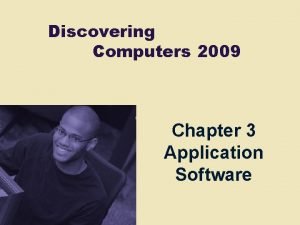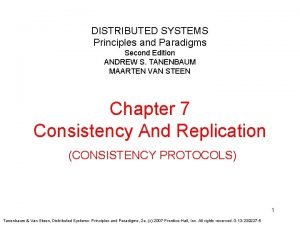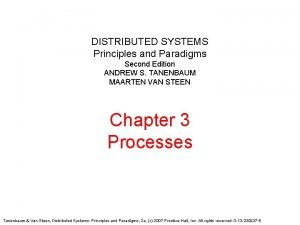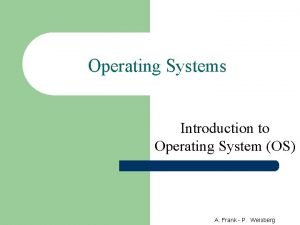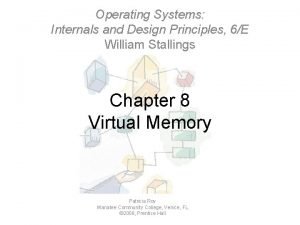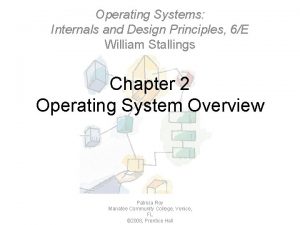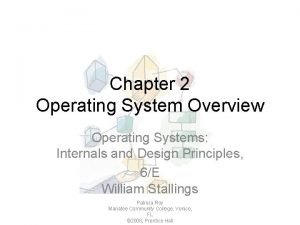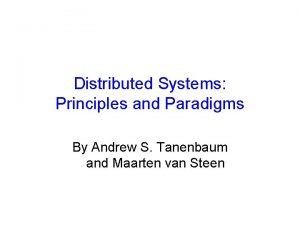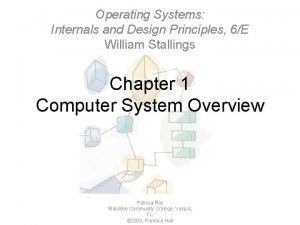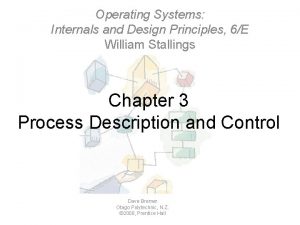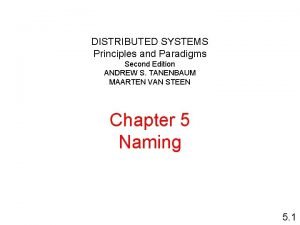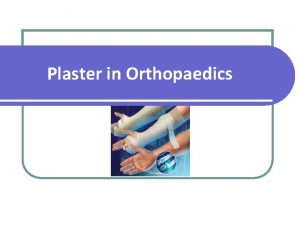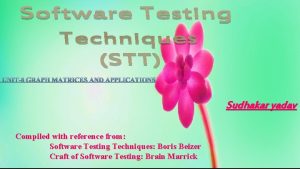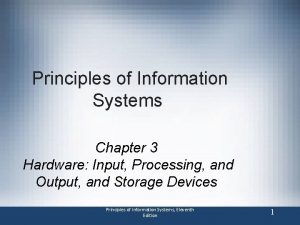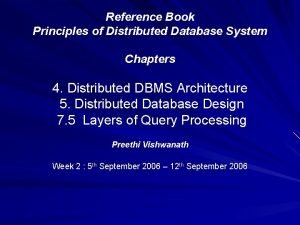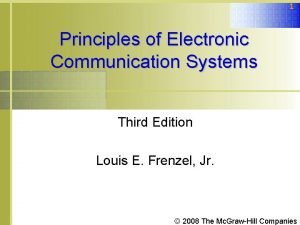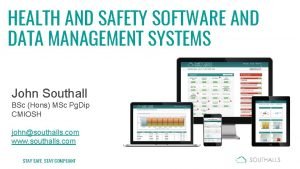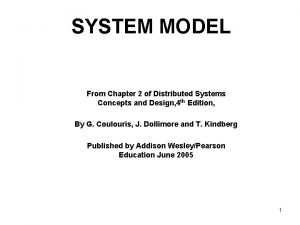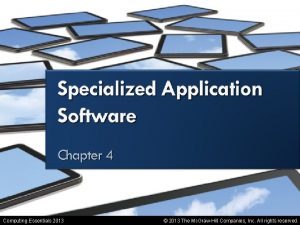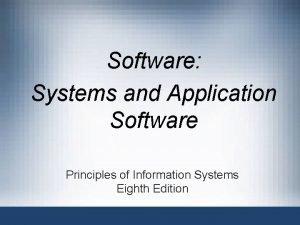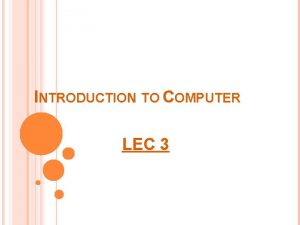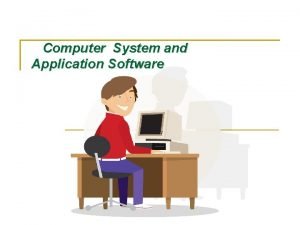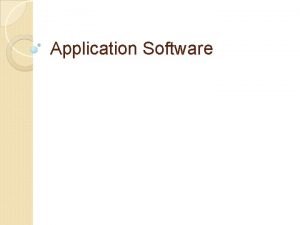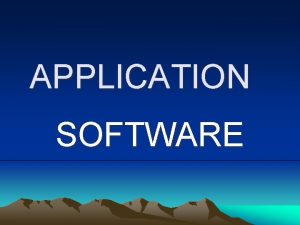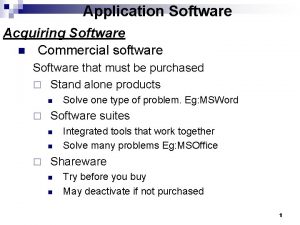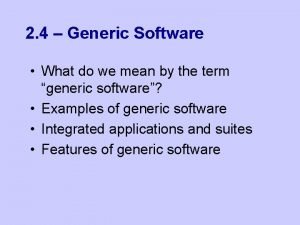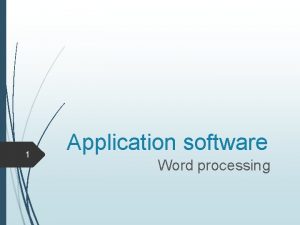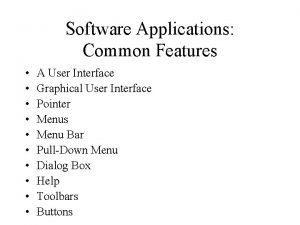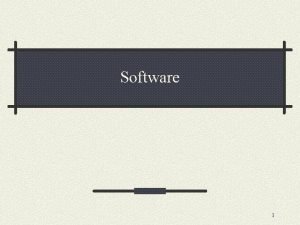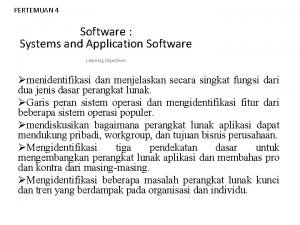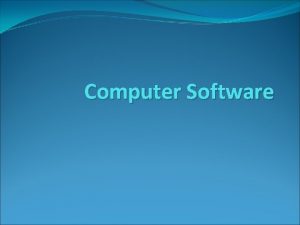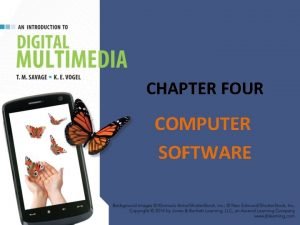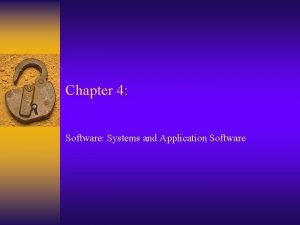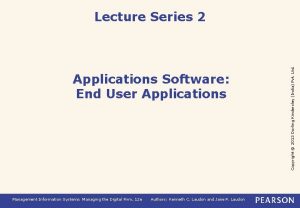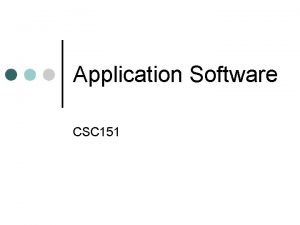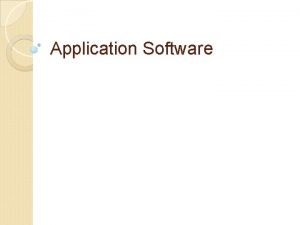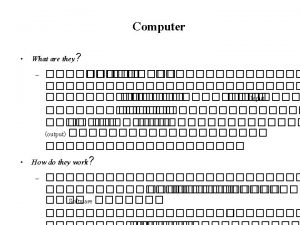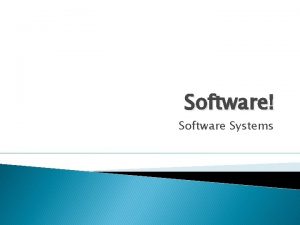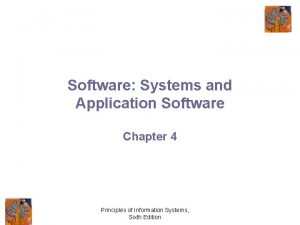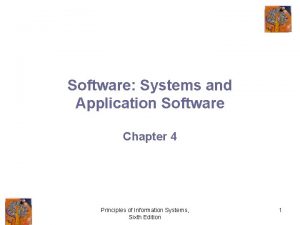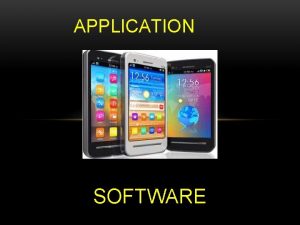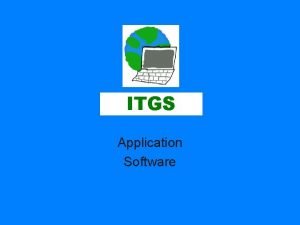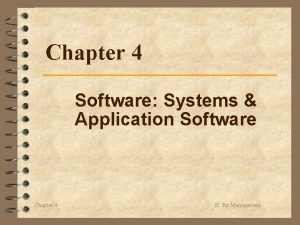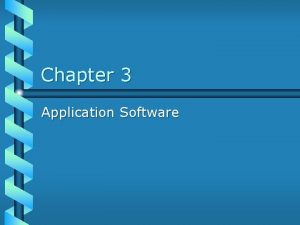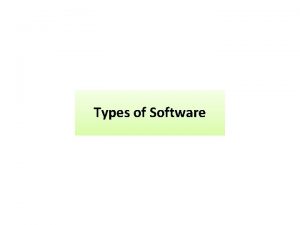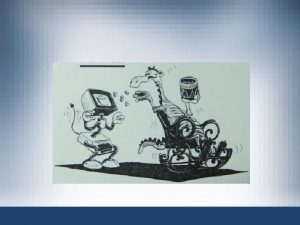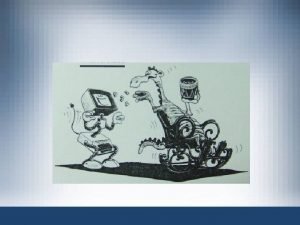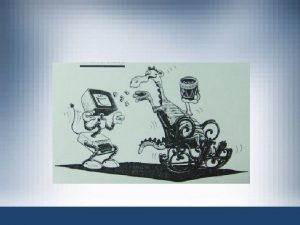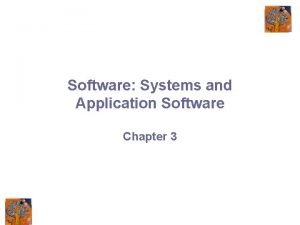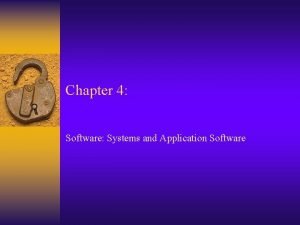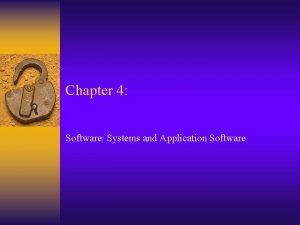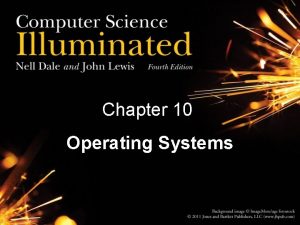Software Systems and Application Software Chapter 4 Principles






















































- Slides: 54

Software: Systems and Application Software Chapter 4 Principles of Information Systems, Sixth Edition 1

Chapter 4 Outline • • • An Overview of Software Systems Software Application Software Programming Languages Software Issues and Trends Principles of Information Systems, Sixth Edition 2

An Overview of Software Principles of Information Systems, Sixth Edition 3

An Overview of Software • Computer program - sequences of instructions for the computer • Documentation - describes program functions • Systems software - coordinates the activities of hardware & programs • Applications software - helps users solve particular problems Principles of Information Systems, Sixth Edition 4

The Importance of Software in Business Principles of Information Systems, Sixth Edition 5

Supporting Individual, Group, and Organizational Goals Principles of Information Systems, Sixth Edition 6

Systems Software: operating systems and utilities Principles of Information Systems, Sixth Edition 7

Operating System Functions • • 1. Perform common hardware functions 2. Provide a user interface 3. Provide hardware independence 4. Memory management 5. Task management 6. Control access to system resources 7. File Management Principles of Information Systems, Sixth Edition 8

The Role of the Operating System Principles of Information Systems, Sixth Edition 9

1. Perform Hardware Functions, 2. Provide A User Interface • Common Hardware Functions – Accept keyboard input – Store data on disks – Send data to output devices • User Interface Types: – Command-based interfaces – Graphical User Interfaces (GUIs) Principles of Information Systems, Sixth Edition 10

3. Hardware Independence Principles of Information Systems, Sixth Edition 11

4. Memory Management Principles of Information Systems, Sixth Edition 12

5. Task Management • Multitasking - more than one program can run at a time using a single processor • Time-sharing - multiple users can simultaneously use the resources of a single processor • Scalability - easy adaptation to more users or tasks Principles of Information Systems, Sixth Edition 13

6. Control Access to System Resources • Protection against unauthorized access • Logins and passwords Principles of Information Systems, Sixth Edition 14

Personal Computer Operating Systems Principles of Information Systems, Sixth Edition 15

Personal Computer Operating Systems Principles of Information Systems, Sixth Edition 16

Types of Operating Systems • WORKGROUP OPERATING SYSTEMS – – – Netware Windows NT Server 4. 0 Windows 2000 Server Unix Red Hat Linux Mac OS X Server • ENTERPRISE OPERATING SYSTEMS • CONSUMER APPLIANCE OPERATING SYSTEMS – – – Windows CE. NET Mobil Linux Windows XP Embedded Handheld PC Pocket PC Palm OS – IBM’s OS/390 – HP’s MPE/i. X (Multiprogramming Executive with integrated POSIX) – IBM’s z/OS – Linux Principles of Information Systems, Sixth Edition 17

Utility Programs Principles of Information Systems, Sixth Edition 18

Application Software: types and functions Principles of Information Systems, Sixth Edition 19

Sources of Software Principles of Information Systems, Sixth Edition 20

Comparison of Proprietary and Off-the-Shelf Software Principles of Information Systems, Sixth Edition 21

personal application software Principles of Information Systems, Sixth Edition 22

Personal and Application Software Principles of Information Systems, Sixth Edition 23

Personal and Application Software Principles of Information Systems, Sixth Edition 24

Turbo. Tax Principles of Information Systems, Sixth Edition 25

Quicken Principles of Information Systems, Sixth Edition 26

Word Processing Principles of Information Systems, Sixth Edition 27

Electronic Spreadsheets Principles of Information Systems, Sixth Edition 28

Database Management Systems Principles of Information Systems, Sixth Edition 29

Graphics Programs Principles of Information Systems, Sixth Edition 30

On-Line Information Systems Principles of Information Systems, Sixth Edition 31

Software Suites Principles of Information Systems, Sixth Edition 32

Major Components of Leading Software Suites Principles of Information Systems, Sixth Edition 33

Workgroup Application Software • Groupware • Collaborative computing software –Lotus Notes • Group Scheduling Principles of Information Systems, Sixth Edition 34

Enterprise Application Software Principles of Information Systems, Sixth Edition 35

Examples of Enterprise Application Software Principles of Information Systems, Sixth Edition 36

Selected Enterprise Resource Vendors Principles of Information Systems, Sixth Edition 37

Programming Languages Principles of Information Systems, Sixth Edition 38

Programming Languages • Commands and statements combined according to a particular syntax • Different languages have different characteristics Principles of Information Systems, Sixth Edition 39

Programming Languages Principles of Information Systems, Sixth Edition 40

First and Second Generation Languages • First Generation Languages – Machine language – ASCII (American Standard Code for Information Interchange) • Second Generation Languages – Assembly languages – Assemblers – Symbolic language Principles of Information Systems, Sixth Edition 41

Third-Generation Languages Principles of Information Systems, Sixth Edition 42

Fourth-Generation Languages • 4 GLs • Programs tell the CPU the desired results, not how to get them • Examples: SQL, SAS Principles of Information Systems, Sixth Edition 43

Fifth-Generation Languages • 5 GLs • Uses a visual or graphical development interface to create source language • Examples: Visual Basic, PC COBOL, and Visual C++ Principles of Information Systems, Sixth Edition 44

Object-Oriented Programming Languages • Objects - data and actions that can be performed on the data • Encapsulation - group items into an object • Polymorphism - one procedure can work with multiple objects • Inheritance - an object in a particular class gets attributes of that class Principles of Information Systems, Sixth Edition 45

Object-Oriented Programming Languages Principles of Information Systems, Sixth Edition 46

Software Issues and Trends Principles of Information Systems, Sixth Edition 47

Software Issues & Trends • • • Software bugs Open source software Software licensing Software upgrades Global software support Antitrust issues for software Principles of Information Systems, Sixth Edition 48

How to Deal with Software Bugs Principles of Information Systems, Sixth Edition 49

Summary • Software - consists of programs that control the workings of the computer hardware • Operating system - set of computer programs that controls the computer hardware • Application - software that applies the power of the computer to solve problems and perform specific tasks • Programming languages - provide instructions to a computer to perform some processing activity Principles of Information Systems, Sixth Edition 50

Principles and Learning Objectives When selecting an operating system, you must consider the current and future for application software to meet the needs of the organization. In addition, your choice of a particular operatiing system must be consistent with your choice of hardware. – IDENTIFY AND DESCRIBE THE FUNCTIONS OF THE TWO BASICS KINDS OF SOFTWARE – OUTLINE THE ROLE OF THE OPERATING SYSTEM AND IDENTIFY THE FEATURES OF SEVERAL POPULAR OPERATING SYSTEMS Principles of Information Systems, Sixth Edition 51

Principles and Learning Objectives • Do not develop proprietary application software unless doing so well meet a compelling business need that can provide a competitive advantage. – DISCUSS HOW APPLICATIONS SOFTWARE CAN SUPPORT PERSONAL, WORKGROUP, AND ENTERPRISE BUSINESS OBJECTIVES. – IDENTIFY 3 BASIC APPROACHES TO DEVELOPING APPLICATIONS SOFTWARE AND DISCUSS THE PROS AND CONS OF EACH. Principles of Information Systems, Sixth Edition 52

Principles and Learning Objectives • The software industry continues to undergo constant change; users need to be aware of recent trends and issues to be effective in their business and personal life. – OUTLINE THE EVOLUTION OF PROGRAMMING LANGUAGES AND DIFFERENTIATE AMONG THE FIVE GENERATIONS OF PROGRAMMING LANGUAGES. – IDENTIFY KEY ISSUES AND TRENDS THAT HAVE AN IMPACT ON ORGANIZATIONS AND INDIVIDUALS. Principles of Information Systems, Sixth Edition 53

End of Chapter 4 Principles of Information Systems, Sixth Edition 54
 Engineering elegant systems: theory of systems engineering
Engineering elegant systems: theory of systems engineering Computer skills for preparatory programs
Computer skills for preparatory programs Is an os system software or application software
Is an os system software or application software Basic principle of ultrasonic testing
Basic principle of ultrasonic testing Application software
Application software Distributed systems andrew s tanenbaum
Distributed systems andrew s tanenbaum Distributed systems principles and paradigms
Distributed systems principles and paradigms Operating systems: internals and design principles
Operating systems: internals and design principles Operating systems: internals and design principles
Operating systems: internals and design principles Operating systems: internals and design principles
Operating systems: internals and design principles Operating systems: internals and design principles
Operating systems: internals and design principles Operating systems: internals and design principles
Operating systems: internals and design principles Distributed systems principles and paradigms
Distributed systems principles and paradigms Operating systems internals and design principles
Operating systems internals and design principles Operating system internals and design principles
Operating system internals and design principles Distributed systems principles and paradigms
Distributed systems principles and paradigms Expert systems: principles and programming, fourth edition
Expert systems: principles and programming, fourth edition Decision support systems and intelligent systems
Decision support systems and intelligent systems Types of plaster of paris in orthopedics
Types of plaster of paris in orthopedics Ndia evms
Ndia evms Main software categories
Main software categories Building tools of graph matrices
Building tools of graph matrices Chapter 24 the immune and lymphatic systems and cancer
Chapter 24 the immune and lymphatic systems and cancer Chapter 24 the immune and lymphatic systems and cancer
Chapter 24 the immune and lymphatic systems and cancer Principles of information systems
Principles of information systems Principles of electronic communication systems 3rd edition
Principles of electronic communication systems 3rd edition Principles of information systems 11th edition
Principles of information systems 11th edition Correctness rules of fragmentation
Correctness rules of fragmentation Fundamentals of information systems chapter 1
Fundamentals of information systems chapter 1 Principles of electronic communication systems 3rd edition
Principles of electronic communication systems 3rd edition Embedded systems vs cyber physical systems
Embedded systems vs cyber physical systems Engineering elegant systems: theory of systems engineering
Engineering elegant systems: theory of systems engineering Chapter 5 elasticity and its application multiple choice
Chapter 5 elasticity and its application multiple choice Software design principles correctness and robustness
Software design principles correctness and robustness Dss systems & software technologies ltd
Dss systems & software technologies ltd Systems integration plan
Systems integration plan Southall safety cloud 2
Southall safety cloud 2 Interaction model in distributed system
Interaction model in distributed system Specialized software examples
Specialized software examples What are the 5 examples of software?
What are the 5 examples of software? 3 computer software
3 computer software Function of system software
Function of system software Software
Software Unlike application software programs
Unlike application software programs Commercial application software
Commercial application software Generic application software
Generic application software Is word a software application
Is word a software application Common features of software
Common features of software The complete software system is divided into
The complete software system is divided into Off the shelf application software examples
Off the shelf application software examples What is interface between user and hardware
What is interface between user and hardware Four types of application software
Four types of application software Chapter 4
Chapter 4 End user applications
End user applications System software consists of
System software consists of




